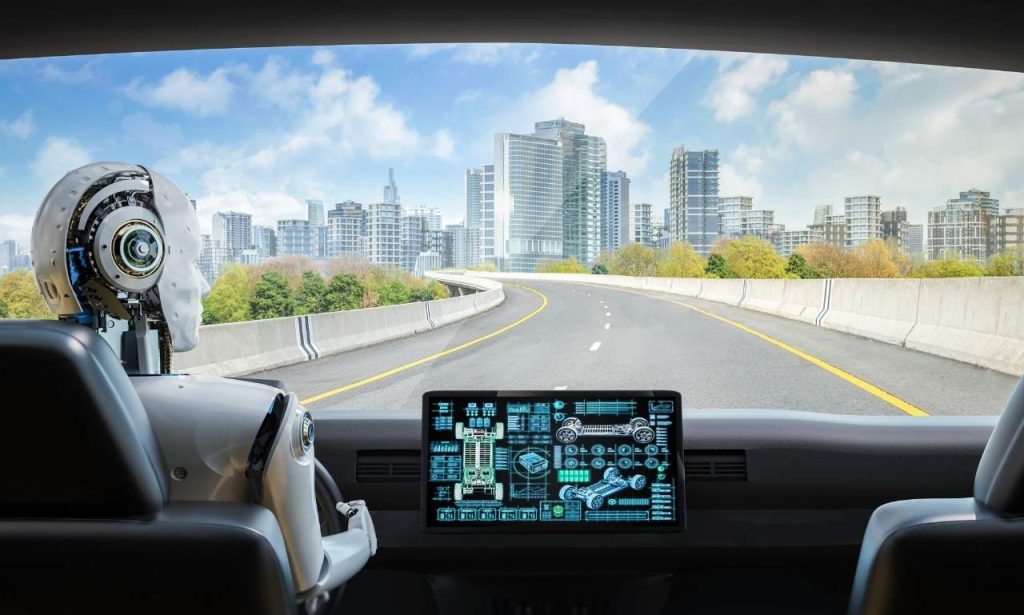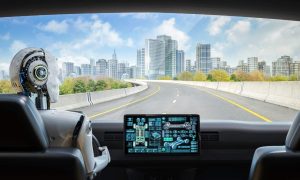Remember getting stuck in that awful traffic jam last month? We’ve all been there. The transportation landscape is changing fast, and artificial intelligence is driving this transformation. From cars that drive themselves to traffic lights that actually seem to know what they’re doing, AI is reshaping how we move. Smart transportation isn’t just about convenience. It’s about creating safer roads, cleaner air, and more efficient systems. AI doesn’t get tired, distracted, or check text messages while driving. It processes information constantly and makes decisions faster than any human could. Let’s explore the role of AI in automotive and how these intelligent systems are changing transportation forever.
Benefits of AI in Smart Transportation
Enhanced Safety Features

Safety comes first in any transportation discussion. AI has transformed vehicle safety systems beyond what anyone imagined possible twenty years ago. These systems work tirelessly to protect us on every journey.
Computer vision technology can spot dangers before human eyes detect them. Advanced sensors monitor blind spots and alert drivers to potential collisions in milliseconds. AI algorithms process camera feeds to identify pedestrians, cyclists, and obstacles with remarkable accuracy.
My cousin’s new car braked automatically when a child darted into the street last week. The car noticed and responded before she could even move her foot. These split-second reactions save lives every day on roads worldwide.
Fatigue detection systems monitor driver alertness through eye-tracking and steering patterns. Weather-adaptive cruise control adjusts vehicle speed based on rain, snow, or fog conditions. Night vision assistance helps identify hazards in darkness well beyond headlight range.
The numbers speak volumes. Cars equipped with AI safety features show accident reduction rates of up to 40%. Insurance companies have noticed too, offering discounts for vehicles with these technologies.
Improved Traffic Management
Traffic congestion costs billions in wasted fuel and productivity annually. AI offers solutions through smarter traffic management systems that learn and adapt continuously.
Smart traffic lights adjust their timing based on real-time traffic flow. These systems can reduce wait times by up to 25% during rush hour. Gone are the days of sitting at a red light with no cross traffic in sight.
Traffic cameras paired with AI analyze patterns and predict congestion before it happens. City planners use this data to redesign problematic intersections and improve road layouts. Commuters receive alternate route suggestions before slowdowns occur.
I noticed the difference on my daily commute after my city installed these systems. My travel time dropped by twelve minutes on average. That’s an hour saved every work week!
Dynamic tolling adjusts prices based on current traffic density to encourage off-peak travel. Emergency vehicles receive priority through traffic signal preemption controlled by AI systems. Construction zones benefit from adaptive routing to minimize disruption and maintain safety.
The future looks even brighter. Cities testing fully integrated systems report traffic flow improvements of nearly 35%. Imagine what we could do with all that saved time!
Reduced Emissions and Fuel Consumption
Environmental concerns drive many transportation innovations today. AI helps vehicles run cleaner and more efficiently through various technologies.
Smart route planning calculates the most fuel-efficient paths based on traffic, elevation, and vehicle type. Drivers save money while producing fewer emissions without changing their destinations. Engine management systems optimize fuel injection and timing constantly.
The impact adds up quickly. Fleet vehicles using AI optimization report fuel savings averaging 15%. That translates to significant emission reductions across entire transportation networks.
My neighbor drives for a delivery company that implemented AI route optimization last year. His daily fuel consumption dropped by almost three gallons. Multiply that by thousands of drivers every day.
Traffic smoothing algorithms reduce the stop-and-go driving that wastes fuel and increases pollution. Electric vehicles use AI to maximize battery range and optimize charging schedules. Public transit systems carry more passengers with fewer vehicles through demand-responsive scheduling.
These improvements don’t require massive infrastructure changes. Simple software updates can transform existing transportation systems into greener operations almost overnight.
AI-Powered Autonomous Vehicles
Definition and Functionality
Autonomous vehicles represent the most visible application of AI in transportation. These self-driving cars combine multiple technologies to navigate without human control.
The heart of any autonomous vehicle is its perception system. Lidar, radar, cameras, and ultrasonic sensors create a complete picture of surroundings. Machine learning algorithms interpret this data to identify objects and predict their movements.
Decision-making happens through complex neural networks trained on millions of driving scenarios. These systems improve through experience, learning from every mile driven. Path planning algorithms calculate safe trajectories while considering traffic rules and conditions.
I recently rode in a test vehicle during a technology conference. The smooth operation surprised me. The car handled an unexpected road closure better than many human drivers would have.
Most autonomous vehicles operate on five defined levels of automation. Level one provides basic assistance like cruise control. Level five offers full automation without any human input needed. Most current commercial systems operate between levels two and three.
The technology continues advancing rapidly. Test vehicles now navigate complex urban environments with pedestrians, cyclists, and unpredictable elements. Rural and weather-challenged driving scenarios remain more difficult but improve yearly.
Major Players in Development
The race to develop fully autonomous vehicles has attracted diverse competitors. Traditional automakers compete with tech giants and specialized startups in this growing field.
Tesla leads with its Autopilot system deployed in hundreds of thousands of vehicles worldwide. Their real-world data collection advantage helps improve their systems continuously. Waymo, formerly Google’s self-driving project, focuses on dedicated autonomous taxi services.
Traditional manufacturers like GM, Ford, and Toyota have invested billions in autonomous research. Their approach typically emphasizes safety and integration with existing product lines. Partnerships between automakers and tech companies combine manufacturing expertise with software innovation.
I spoke with an engineer from one of these companies at a recent conference. She emphasized that collaboration drives progress faster than competition alone. Sharing certain safety findings benefits everyone in the industry.
Universities play crucial roles in fundamental research and talent development. Companies like Mobileye specialize in the vision systems that enable autonomous functions. Startups focus on specific challenges like all-weather operation or specialized vehicle types.
The autonomous vehicle market could exceed $500 billion annually within a decade. Beyond passenger cars, the technology extends to trucks, buses, delivery vehicles, and specialized applications.
Regulatory Challenges
Autonomous vehicles face significant regulatory hurdles before widespread adoption becomes possible. Legal frameworks designed for human drivers require extensive updates.
Liability questions remain particularly complex. Who bears responsibility when autonomous systems make mistakes? Insurance models need reinvention for vehicles without human operators. International standards development lags behind technological capabilities.
Testing regulations vary widely between jurisdictions, creating compliance challenges. Some states welcome autonomous testing while others impose strict limitations. Companies must navigate this patchwork of requirements while developing universal technologies.
My state recently passed legislation addressing autonomous vehicle testing requirements. The public hearings revealed diverse concerns from various stakeholders. Safety advocates, industry representatives, and privacy experts often hold conflicting views.
Data privacy presents another regulatory frontier. Autonomous vehicles collect massive amounts of information about roads, passengers, and surroundings. Rules about data ownership, storage, and usage remain inconsistent globally.
Progress continues despite these challenges. Several jurisdictions have approved limited commercial deployment of autonomous taxis and delivery vehicles. Public opinion gradually shifts as exposure to these technologies increases.
Machine Learning Algorithms in Automotive
Types of Algorithms Used
Various machine learning approaches serve different functions in automotive applications. Each type excels at specific tasks within transportation systems.
Supervised learning algorithms train on labeled data to perform classification tasks. These help identify objects like pedestrians, traffic signs, and road hazards. Reinforcement learning enables systems to improve through trial and error in simulated environments.
Convolutional neural networks specialize in image processing for visual navigation systems. Deep learning powers the most advanced driving decision systems currently in development. Unsupervised learning finds patterns in traffic and driver behavior without predefined categories.
I watched a demonstration where an algorithm identified a partially obscured stop sign in heavy rain. The system processed the image and made the correct decision faster than I could.
Transfer learning allows systems to apply knowledge from one situation to entirely new scenarios. Ensemble methods combine multiple algorithms to achieve greater accuracy and reliability. Natural language processing enables voice control and passenger communication systems.
The most effective automotive AI systems integrate several algorithm types working cooperatively. This combination provides redundancy and comprehensive capability across varying conditions.
Real-time Data Processing
Automotive AI must process enormous data volumes with virtually no latency. This requirement drives specialized hardware and software optimization throughout the industry.
Edge computing brings processing power directly into vehicles rather than relying on cloud connections. This reduces response times to milliseconds rather than seconds. Dedicated AI processors handle specific tasks like vision processing or trajectory calculation.
Sensor fusion combines data from multiple sources to create comprehensive environmental awareness. The average autonomous test vehicle generates several terabytes of data daily. Filtering systems identify relevant information while discarding unnecessary details.
My colleague works on data compression algorithms for autonomous systems. Their team reduced bandwidth requirements by 60% while maintaining decision quality. Such innovations make these systems more practical for mass deployment.
Real-time mapping updates ensure vehicles operate with current road information. V2X (vehicle-to-everything) communication provides additional data from infrastructure and other vehicles. Weather and traffic condition feeds adjust system parameters for optimal performance.
These processing capabilities extend beyond autonomous driving. Conventional vehicles increasingly use similar systems for driver assistance and safety features.
Impact on Vehicle Performance

AI enhances vehicle performance beyond just autonomous capabilities. These technologies improve efficiency, comfort, and reliability across transportation systems.
Predictive maintenance algorithms identify potential failures before they occur, reducing downtime and preventing dangerous situations. Adaptive performance systems optimize engine parameters based on driving conditions.
Personalized comfort settings learn occupant preferences and adjust accordingly. AI manages battery utilization in electric vehicles to maximize range and lifespan. Advanced suspension systems predict road conditions and adjust damping proactively.
I noticed the difference when testing vehicles with these systems on a mountain road last summer. The ride quality remained consistent despite varying conditions, while traditional vehicles felt comparatively crude.
Fuel efficiency improvements come through microscopic adjustments to multiple vehicle systems. AI optimizes regenerative braking in hybrid and electric vehicles to recover maximum energy. Aerodynamic elements adjust automatically at different speeds to reduce drag.
These performance enhancements often arrive through software updates rather than mechanical changes. This allows continuous improvement throughout a vehicle’s operational life.
Conclusion
The marriage between artificial intelligence and transportation marks a pivotal moment in mobility history. These technologies promise safer roads, cleaner air, and more efficient movement for everyone.
Progress continues at an astonishing pace. Each year brings capabilities that seemed impossible just months earlier. Communities worldwide have started embracing these changes through pilot programs and updated infrastructure.
The transformation extends far beyond just vehicles. Entire transportation ecosystems evolve as these technologies mature. The benefits reach everyone from daily commuters to goods transportation systems.
I can’t help feeling optimistic about this transportation revolution. The challenges remain significant, but the potential rewards make them worth tackling. The future of mobility looks intelligent, connected, and surprisingly human-centered.
Will we miss driving ourselves? Maybe occasionally. But the freedom of movement without the stress of traffic might be worth the trade. The journey toward this future has already begun.
Also Read: How Litigation Teams Can Navigate the AI Era With Confidence
FAQs
Most experts predict limited deployment in specific areas within 3-5 years, with widespread adoption taking 10-15 years.
Current data shows promising safety improvements, but the technology continues developing toward the goal of significantly surpassing human safety records.
A transition period lasting decades will likely include mixed autonomous and human-driven vehicles before full automation becomes universal.
Multiple redundant systems and fail-safe mechanisms ensure vehicles can reach safe stopping conditions even during system failures.


